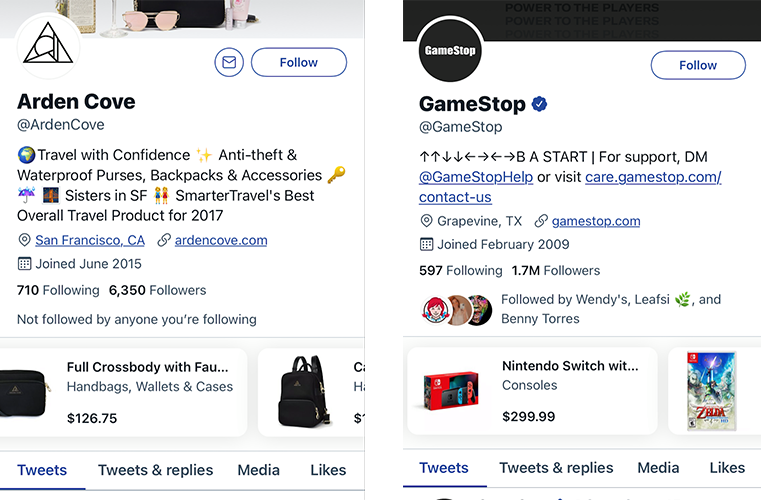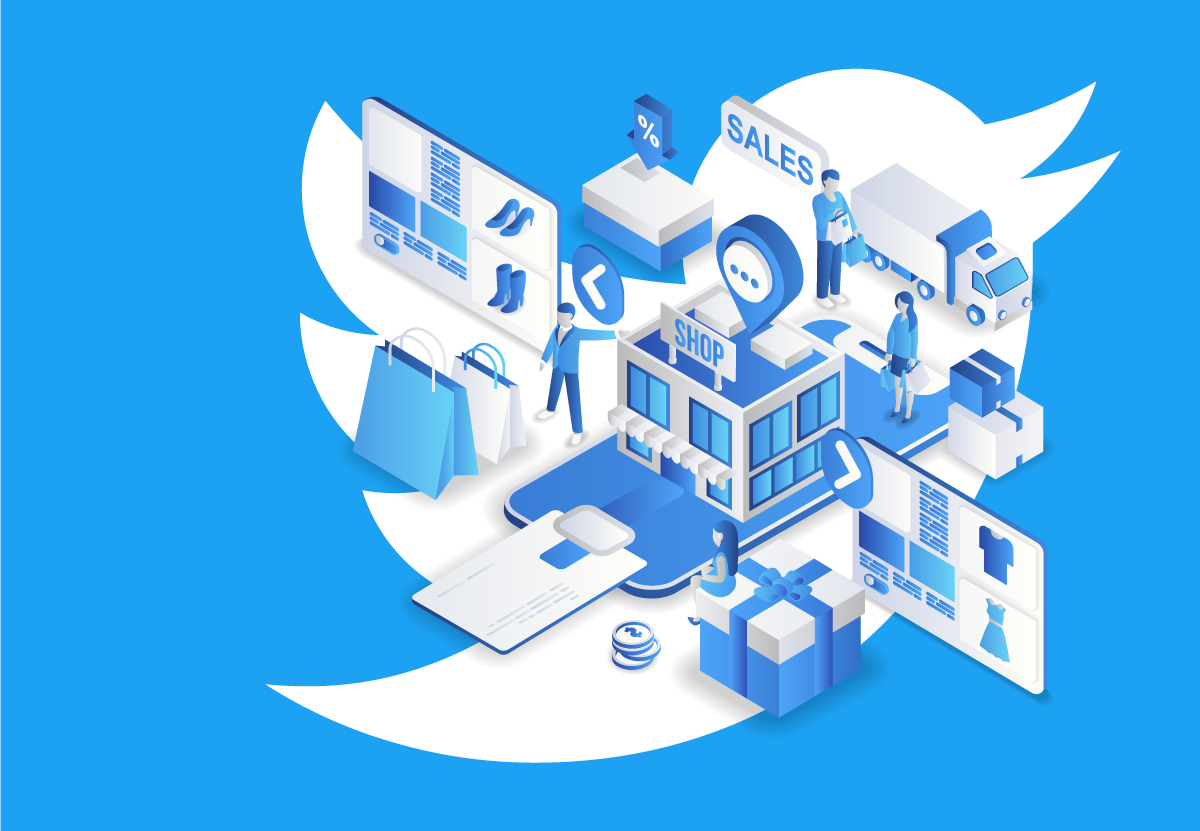Twitter’s done it again – another new thing.
Well, kind of.
Social commerce is hardly new, and it’s not even new to Twitter (more on that later). But with Instagram and Facebook continuing to up their in-app ecommerce game, Twitter has decided to join the club.
Earlier this year, the platform began testing ecommerce tweets that have a Shop Button linking to product pages.
On Wednesday, July 28, Product Lead Bruce Fleck announced the launch of the Shop Module: a new way to buy and sell on Twitter.
What Is the Shop Module?
The Shop Module creates shoppable profiles for ecommerce businesses via a small carousel of products located under their profile bio.

Consumers can navigate to your page and scroll through the carousel to browse products. Tapping on a product opens the product’s page on your website for users to learn more and – hopefully – make a purchase.
And, per other social commerce channels, the process is handled entirely within Twitter’s app.
Who Has Access?
For this first round of testing, only 10 brands within the US have access to the shopping module. To interact with it, users must be in the US and use Twitter in English on an iOS device.
Ecommerce businesses also have to have a Professional Profile to use the module – another feature launched in April of this year.
The Professional Profile allows businesses to showcase information like their hours and address (not exactly pertinent to ecommerce except that you will need one to use the Shop Module).

Among the 10 brands testing the feature are:
@GameStop
@ArdenCove
@nikestore
@Walmart
@WaltDisneyWorld
@patagonia
@Google
@LatinxInPower
As you can see, Twitter is testing a diverse lineup to see what appeals to users. The most interesting of the group is the Latinx In Power podcast, with only 704 followers at the time of this article.
A Merchant Advisory Board for Businesses
In the same post that Bruce Fleck announced the Twitter shopping feature, he also mentioned a new Merchant Advisory Board.
The board’s goal is to provide a platform that speaks on behalf of Twitter businesses and provides insight into the needs of businesses on Twitter. Fleck said that the board will consist of “best-in-class examples” of merchants on Twitter.
This Is Twitter’s Second Crack at Ecommerce
Now, this isn’t the platform’s first venture into the ecommerce space, and businesses have reason to be wary of selling on Twitter.
Twitter first invested in ecommerce back in 2014 when it rolled out a Buy Now button that embedded product links into tweets. And yes, it does sound familiar to the Shop button they’re working with now.
Then, in 2015, the company tested a Products and Places feature that functioned as a way for brands and influencers to share product collections.
Twitter phased both features out within a couple of years as they gained no traction, and the removal of the features was as slow as the start. The Buy Now button was officially dropped in 2017, nearly a year after Twitter disbanded its commerce team altogether.
So, why is Twitter hoping for a second chance?
In a tweet thread, Twitter Investor Relations relayed the words of Twitter CFO, Ned Segal, during the Morgan Stanley Technology, Media and Telecom Conference back in March:
“…We’re also thinking about commerce. Helping people buy things on Twitter. We want to be really thoughtful about how we do this so that we’re helping advertisers find their customers and continue to own that relationship with the customer.”
Segal attributes the venture to Twitter not doing enough to optimize the platform for small businesses in the past.

What to Expect as an Ecommerce Business
For starters, the rollout of Twitter’s ecommerce features could take a while. In the past, it took a year for the company to make its Buy Now button available to more major ecommerce platforms like Shopify.
Then there’s the fact that Twitter has attempted and failed at ecommerce before. For those who hope to take a positive perspective, Twitter may have learned from their failure. Some say that Twitter simply wasn’t as invested in joining the ecommerce space back then.
In truth, the ecommerce features the platform did implement failed because users weren’t interested, and we are unsure if that will change.
Brands wanting to sell doesn’t guarantee that people will buy. And people don’t really use Twitter to shop.
It’s Counterintuitive to Twitter’s Modus Operandi
Twitter is a platform used to obtain the latest news and updates, keep up with celebrities and follow the in-the-moment thoughts of the people you like (and sometimes the people you don’t). It’s the fastest-paced of the social media giants.
In other words, shopping doesn’t really fit into the flow unless the power of influencers is maximized and users use product links when sharing their excitement or disappointment with a purchase (a double-edged sword in itself).
On another note, one of the reasons that Instagram has capitalized so well on online shopping is that it’s a visual platform. People see pictures and videos of products that blend in with their feed. An influencer showing off a lifestyle item is easy and natural.
We’re not saying Twitter brands can’t get more visual, but the nature of the platform results in a digital space that looks more like a messaging board.
Users Have to Visit Your Profile
When was the last time you went to a brand’s profile page on Twitter? (Not including efforts to check out the new shop module).
It’s probably recent, and you’re in the industry. You need to evaluate competitors, successful strategies and generate content ideas.
Consumers aren’t doing that.
There are always exceptions, but most of the time, consumers stick to their home feed.
Nothing Is Free
While Twitter might be trying to help businesses because it’s their good deed of the year, we know they’re also trying to make a profit.
The point of enabling advertising and shopping on social media is to make money. It’s why Facebook and Instagram charge a flat fee or take a percentage of your sale depending on the order value.
Twitter announced earlier this year that its goal is to double its revenue by 2023.
The company has already begun initiating more ways to monetize, including its new Twitter Blue subscription.
Even if the Shop Module starts off free or at a discount, you can bet that Twitter will charge for the feature. It will be up to ecommerce businesses to decide if the price is worth the value.
Is Twitter Just Struggling to Differentiate?
It appears that Twitter is having a difficult time differentiating itself – or at the very least understanding its focus and purpose.
This isn’t the first time in recent history that Twitter has attempted to follow in the footsteps of Instagram and Facebook.
The platform recently pulled the plug on Fleets – what had been its version of “stories.” The feature was unsuccessful and went primarily unused because the nature of tweets is already fleeting. Users didn’t have a need for it, and Twitter failed to predict this with an understanding of its own product.
In response to the end of Fleets, Twitter Product Lead Kayvon Beykpour explained that Twitter’s internal philosophy includes taking “big bets.” He said, “If we’re not having to wind down features every once in a while, then it would be a sign that we’re not taking big enough swings.”

To be fair to Twitter, many of the social media giants have borrowed from each other for years as they become more and more alike. But now that Twitter’s new focus is ecommerce, we can’t help but wonder how this “big bet” will turn out.


